Yoga Inversions:
Jump To:
Inversions are a unique feature of yoga. Yoga texts define the concept behind inversion poses as viparita karani, which means “opposite process”. There are a number of yoga inversions benefits. The following 4 yoga inversions poses clears up the toxins from your body and mind.
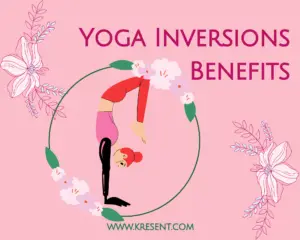
Indeed, inversions offer a different perspective; physically, the body is supported differently, enhancing focus and concentration.
Are Yoga Inversions Safe?
Yes, yoga inversions are safe if done correctly and they give us a variety of yoga inversions benefits. In fact, any yoga should be done correctly by practicing and gradually getting to perfection.
The Yoga inversions poses are done with the feet above the head during the practice. This elicits as much fear as fascination.
It is very important to be aware of body alignment and to adopt these poses gradually, under the guidance of a yoga teacher, according to one’s physical ability and comfort level to reduce the risk of injury.
These poses call for proper breathing, heightened awareness and significant core and shoulder strength.
Inversions are not meant for those who are pregnant, menstruating, have pre-existing injuries especially neck injuries, high blood pressure, detached retina, epilepsy and heart conditions.
Yoga Inversions Benefits:
Yoga inversions are strengthening postures, which when performed correctly, offer special benefits.
- They strengthen the muscular-skeletal system, the shoulders, back, abdomen and legs that work against gravity.
- They stimulate circulation as everything moves in the opposite direction; blood pumped from the heart to the belly and legs is reversed.
- Headstand and shoulder stand stimulate the glandular and hormonal systems resulting in better balance and increased vitality.
- Ayurveda considers that many of the body’s impurities are in the lower abdomen. Inversions help getting rid of these.
Inversions increase your ability to breathe well while you are upside down! The back and stomach muscles provide the support to hold the legs straight.
Yoga Inversions Poses:
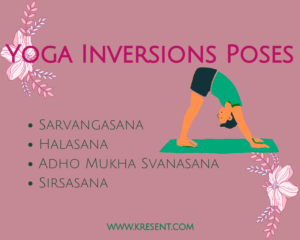
1. Sarvangasana (Shoulder stand):
This asana is referred to the queen of all asanas.
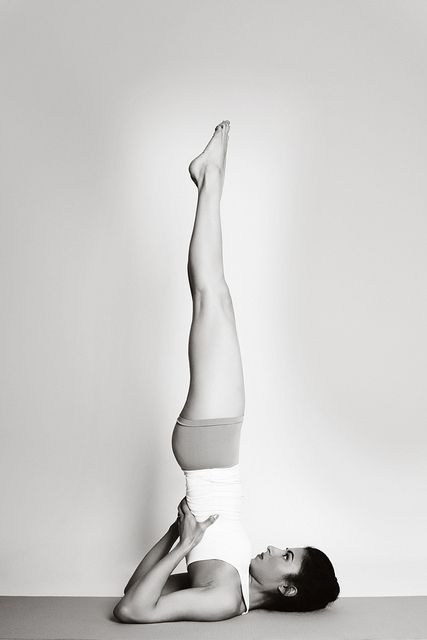
Sarvangasana Steps:
- Lie on a mat or folded blanket, bend your knees, contract your abdominal muscles and lift your back supporting it with your palm.
- Bring your feet and knees together, and straighten your bent knees toward the ceiling.
- Breathe slowly, gaze softly into the chest, relax the facial muscles and make sure there is no pressure or tension in the neck region. Stay in this position for a while; beginners can remain for 30 seconds and gradually increase it to 5 minutes.
- Exhale, bend the knees, and return to center and rest for several seconds.
Beginner’s tip:
Beginners can start in a half inverted variation by only lifting the legs upwards to a 45 degree angle and practice along a wall. This eases the pressure and weight on the neck and shoulders. If you feel your alignment is not quite right, come down and do it again.
Shoulder Stand Benefits:
- Stimulates the thyroid and prostate glands and abdominal organs
- Improves digestion
- Relieves stress, depression and alleviates insomnia
2. Halasana (Plow pose):
It’s important to stay in the pose for at least one to five minutes in order to reap the full benefits.
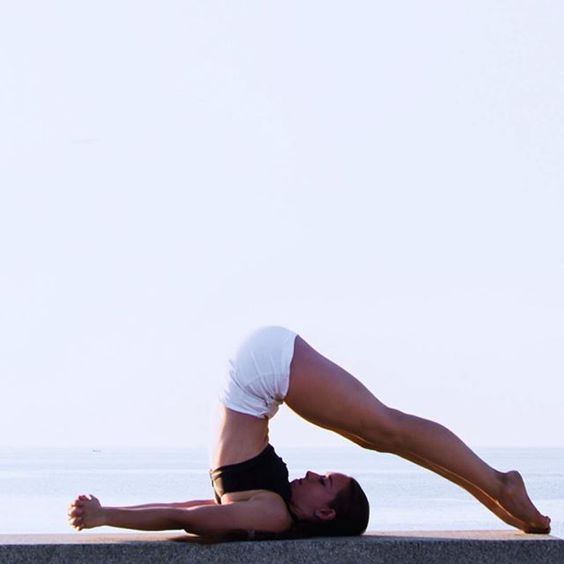
Halasana Steps:
- Lie down on your back and lift your legs up over your head and then lower to the ground behind you.
- Keep your hands on the ground on either side of your body or brace them on your back for extra support.
Or
From the shoulder stand position; slowly lower both your feet to the floor behind your head. Your legs should be straight and toes on the floor.
Halasana Benefits:
- Stimulates the thyroid and prostate glands and abdominal organs
- Stretches the legs and spine
3. Adho Mukha Svanasana (Downward Facing Dog Pose):
This pose also calms the mind, lengthens the spine and energizes the body.

Adho Mukha Svanasana Steps:
- Stand on your four limbs like a table with palms placed shoulder-width apart and toes placed hip-width apart parallelly. Tuck your toes inward.
- Exhale; lift the knees off the floor, legs straight and form an inverted V-shape pushing the body weight into the palms and hips up towards the ceiling.
- Attempt to touch your heels to the ground, while keeping your legs straight at the knees.
- Push away from the ground through your palms, keeping your shoulders square and head between your arms. Keep neck neutral and body weight evenly distributed. Touch the ears to the inner arms and sink your hands into the ground.
- Stay in this position and take deep breaths.
Release the pose getting back to table pose bending your knees while exhaling.
Adhomukha svanasana Benefits:
- This pose strengthens the back, neck, shoulders and legs.
- It improves circulation and restores energy.
4. Sirsasana (Head Stand):
A good way to turn your world around and look at it from a new angle.
To do the headstand you need to balance well. This asana is referred to the king of all asanas.
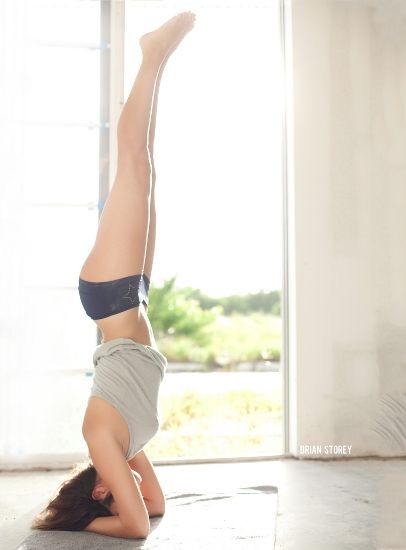
Sirsasana Steps:
- Come to a kneeling position.
- Place your forearms on the center of your mat and your head between the hands.
- Now , walk the feet up toward the elbows. Slowly raise both feet together into a head stand.
Sirsasana Benefits:
- This pose strengthens the back, neck, shoulders and legs.
- It sends blood to the brain and nourishes the brain cells.
FAQs
What is the easiest yoga inversion?
Crow pose, headstand and shoulder stand are some of the easiest yoga inversions for beginners.
Who should not do inversions in yoga?
Contraindications for inversions are the following; high blood pressure, history of stroke or heart disease, diabetes, pregnancy beyond the first trimester, glaucoma or other eye disorders, spinal problems, chronic neck pain, excess weight, dizziness, head injuries, inner ear problems, hiatus hernias and osteoporosis.
Is Downward Dog an inversion?
Yes, Downward Dog is an inversion! In Downward Dog, though, your head is below your heart and it’s a safe way to start to feel how you engage your arms, legs and core in an upside down positions.
Are yoga Inversions safe?
Along with the risk of causing stress on your spine, those practicing inversions also run the obvious risk of falling in a way that causes stress or trauma to their bodies. This could cause anything from a mild to severe injury, so it’s definitely something to watch out for.
Is inversion good for your brain?
Inversions increase the blood flow to the brain, giving it more oxygen and nutrients and making the brain function faster and better. This improves concentration, memory, observation and boosts clear thinking.
How long does it take to learn yoga inversions?
It may take twenty classes before you can hold an inversion for two seconds, but it’s better to be deliberate with your progress than to rush into a pose unprepared and risk injury.